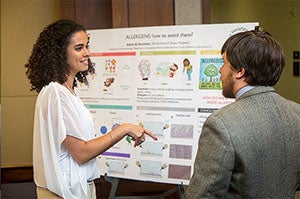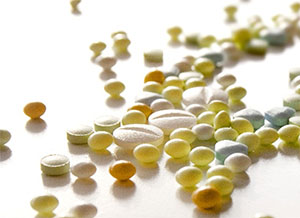
Illustrated by: Amanda Acuna
Being sick is no fun. You might wake up and think, “uh oh, I don’t feel so good”. You are super tired, have chills, your nose is runny, and you have a nasty cough. These symptoms make being sick miserable. Many people don’t want to eat, see friends, play, or move around. These changes in how you behave are called “sickness behaviors”. They happen when you are infected with a bug like a virus, bacteria, or parasite. It may seem like the bug you are infected with is making you feel this way, but it’s actually your body’s immune system.
When you get sick and your body temperature increases, you have what is called a fever. But what does a fever do for you? Besides making you feel sick, high body temperatures are one way your immune system tries to get rid of an infection. It increases your body temperature because higher temperatures help to fight the bug (like the flu virus). When you cough and sneeze, it’s your body’s way of expelling, or forcing out, the bug. It might not be fun, but these symptoms are actually very useful.
Infections aren’t the only way we get sick. Toxin exposure causes symptoms like chills, diarrhea, vomiting, and stomach pain. This happens really fast so your body can flush out the toxin before it does too much harm. However, we don’t know much about toxin inflammation and nothing at all about sickness behaviors to toxins. Researchers like Esther Florsheim are trying to figure out what those responses are.
Why care about toxins? Florsheim says that diarrheal diseases due to toxins are one of the top five causes of death for children under 5 years old. People are also getting more concerned about toxins in our food due to climate change. For example, climate change is making the Earth warmer, which helps harmful fungi grow more easily on crops. These fungi produce toxins that can make food less safe to eat. As the weather gets hotter, these fungi can also spread more quickly and to places they aren’t typically found, which makes this a bigger problem for our food.
Toxic Behavior

Florsheim is curious about how our body responds to toxins. She says that when you are ill, sickness behaviors are not just side effects of having an infection. A part of your immune system’s fight against infection is making behaviors to protect you and the people around you. Being tired and resting so your body can recover helps your body deal with the infection. Not feeling social means that you will stay away from others, which can stop the spread of disease.
What happens during the immune response to toxins?
Toxins are typically molecules so “there’s no way to just kill them”, says Florsheim. “So how do you deal with that? What happens in terms of behavior?” She thinks that although some toxin sickness behaviors are the same as when a person has a bug, some are different. Her lab tests this by observing behavior after exposure to toxins. They also look at different tissues using a microscope to see what immune cells are doing in places in the body like the gut. “We haven’t tried all types of toxins yet”, she says, but so far, her laboratory has found some differences. During an infection, they see depressive behaviors like moving less and avoiding others but after toxin exposure, they see more anxious behaviors like moving more. This work gives us a clue to how the body and brain respond to toxins, which may lead to better treatments.
Toxic Thinking

Though we often think of toxins as negative, Florsheim points out that they can be useful. “We can also think of toxins as medicinal,” she says. Throughout our history, humans have used plant toxins for healing purposes. For example, the wormwood plant (Artemisia absinthium) contains a chemical that can be pretty toxic. However, when used correctly and in the right amount, it has been used in Chinese medicine to help with issues like muscle pain and wound healing. Recently, a scientist named Youyou Tu figured out how to use this plant to make a medicine to treat people with an illness called malaria. In fact, she earned a Nobel Prize in 2015 for this discovery, which is a big honor for a scientist. By better understanding the effects toxins have on the body, we might be able to figure out how to use them in a positive way. We don’t know yet, but this could lead to treatments for chronic inflammatory diseases and food allergies. “We are trying to understand fundamental biological principles that can apply to many organisms following toxin exposure”, she says. Florsheim's work might lead to new ways to improve health outcomes and help us better understand our immune system.
Read more about: Toxic Response
Bibliographic details:
- Article: Toxic Response
- Author(s): Amanda Acuna
- Publisher: Arizona State University School of Life Sciences Ask A Biologist
- Site name: ASU - Ask A Biologist
- Date published:
- Date accessed:
- Link: https://askabiologist.asu.edu/explore/Toxic-Response
APA Style
Amanda Acuna. (). Toxic Response. ASU - Ask A Biologist. Retrieved from https://askabiologist.asu.edu/explore/Toxic-Response
Chicago Manual of Style
Amanda Acuna. "Toxic Response". ASU - Ask A Biologist. . https://askabiologist.asu.edu/explore/Toxic-Response
Amanda Acuna. "Toxic Response". ASU - Ask A Biologist. . ASU - Ask A Biologist, Web. https://askabiologist.asu.edu/explore/Toxic-Response
MLA 2017 Style

Florsheim’s laboratory investigates toxins like those produced by bacteria like Vibrio cholerae (cholera toxin).
Be Part of
Ask A Biologist
By volunteering, or simply sending us feedback on the site. Scientists, teachers, writers, illustrators, and translators are all important to the program. If you are interested in helping with the website we have a Volunteers page to get the process started.
